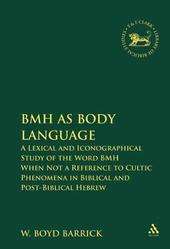
|
BMH as Body Language: A Lexical and Iconographical Study of the Word BMH When Not a Reference to Cultic Phenomena in Biblical an
Hardback
Main Details
| Title |
BMH as Body Language: A Lexical and Iconographical Study of the Word BMH When Not a Reference to Cultic Phenomena in Biblical an
|
| Authors and Contributors |
By (author) Dr. W. Boyd Barrick
|
| Series | The Library of Hebrew Bible/Old Testament Studies |
|---|
| Physical Properties |
| Format:Hardback | | Pages:208 | | Dimensions(mm): Height 234,Width 156 |
|
| Category/Genre | Historical and comparative linguistics
Biblical studies |
|---|
| ISBN/Barcode |
9780567026583
|
| Classifications | Dewey:492.47 |
|---|
| Audience | | Postgraduate, Research & Scholarly | |
|---|
|
Publishing Details |
| Publisher |
Bloomsbury Publishing PLC
|
| Imprint |
T.& T.Clark Ltd
|
| Publication Date |
1 August 2008 |
| Publication Country |
United Kingdom
|
Description
It is customarily assumed that the Hebrew word BMH denotes a "high place," first a topographical elevation and derivatively a cult place elevated either by location or construction. This book offers a fresh, systematic, and comprehensive examination of the word in those biblical and post-biblical passages where it supposedly carries its primary topographical sense. Although the word is used in this way in only a handful of its attestations, they are sufficiently numerous and contextually diverse to yield sound systematic, rather than ad hoc, conclusions as to its semantic content. Special attention is paid to its likely Semitic and unlikely Greek cognates, pertinent literary, compositional, and text-critical matters, and the ideological and iconographical ambiance of each occurrence. This study concludes that the non-cultic word BMH is actually *bomet, carrying primarily (if not always) an anatomical sense approximate to English "back," sometimes expanded to the "body" itself. The phrase bmty->rs (Amos 4:13, Micah 1:3, and CAT 1.4 VII 34; also Deut. 32:13a, Isa. 58:14ab-ba, and Sir. 46:9b) derives from the international mythic imagery of the Storm-God: it refers originally to the "mythological mountains," conceptualized anthropomorphically, which the god surmounts in theophany, symbolically expressing his cosmic victory and sovereignty. There is no instance where this word (even 2 Sam. 1:19a and 1:25b) is unequivocally a topographical reference. The implications of these findings for identifying the bamah-sanctuary are briefly considered.
Author Biography
W. Boyd Barrick is the former dean and part-time instructor of religion at Montana State University-Billings. He is the author of The King and the Cemeteries: Toward a New Understanding of Josiah' Reform.
ReviewsThis book will carry the conversation forward regarding the proper understanding and translation for the words listed under the entry bmh. Lexicographers and Biblicists will find much to think about in Barrick's analysis. -- Hebrew Studies, Volume LII
|